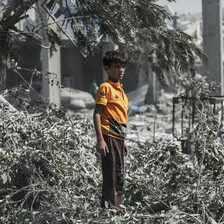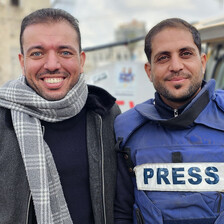The Electronic Intifada 7 October 2024

A Palestinian child looks at the ruins in Gaza City’s al-Zahra area after it was destroyed in Israeli airstrikes, 19 October 2023.
ActiveStillsI never imagined that after years of living abroad, my return to Gaza would be marked by relentless war, the loss of dear ones, and unprecedented deprivation and famine. I booked my flight and returned to Gaza just two months before the war began. Upon my return, I resumed my work with Gaza Municipality, an institution I first joined as a member of the Municipal Children’s Council in 2003.
Gaza Municipality is one of the oldest in Palestine, founded in 1893. Over the decades, it has served the city’s residents despite the difficult conditions and political upheavals Gaza has faced.
Throughout the past 20 years, Gaza has endured several Israeli attacks and wars, including major offensives in 2008, 2012, 2014, 2021 and 2022. The municipality has also navigated emergencies like the COVID-19 pandemic, providing it with valuable experience in crisis management. However, the war that began in October 2023 came as a shock in its timing, duration and scale of destruction.
This war has proven to be one of the most challenging crises Gaza has ever faced.
State of emergency
In response to the catastrophic situation caused by continuous bombardment and immense destruction, Gaza Municipality declared a state of emergency. We launched the emergency war efforts immediately after the Israeli aggression began. Four main priorities were established to support the affected population and ensure the continuation of vital services.
Water supply was the top priority, focusing on providing citizens with water – more than 75 percent of Gaza City’s wells are now damaged, the national water company of Israel Mekorot completely suspended water supply to Gaza City from the onset of the war until May 2024, and damage has forced the shutdown of the desalination plant in the city’s north.
Waste collection became the second priority, with extensive campaigns launched to clear streets and temporary shelters of accumulated waste, which posed severe health and environmental threats. More than 150,000 tons of waste have now accumulated across the city.
The municipality also prioritized sewage management, focusing on diverting wastewater away from populated areas amid the destruction of sewage networks and treatment plants.
Lastly, efforts were made to reopen main roads blocked by Israeli airstrikes, facilitating the movement of emergency teams and providing access to health centers. However, this service remains severely hindered due to the destruction of most of the heavy equipment needed for these operations.
Unprecedented challenges
From the onset of the aggression, Gaza Municipality faced unprecedented challenges that severely affected its ability to deliver essential services. The scale and intensity of the bombardment, alongside the overwhelming firepower, were among the most significant challenges. These factors hindered the municipality’s operations, especially during the early weeks of the war.
Following the complete power outage from the 10th day of the conflict, when Gaza’s only power plant was forced to shut down, the municipality had to rely entirely on generators. However, it became nearly impossible to secure enough fuel to keep them running. Solar energy systems and generators were also destroyed, causing near-total inability to operate water wells and sewage treatment facilities. This in turn exacerbated the water and sanitation crises.
Moreover, Israeli forces destroyed 127 heavy and medium-sized vehicles – 80 percent of the fleet that the municipality relied on for waste collection and the maintenance of water and sewage networks.
This led to a severe halt in basic services. More than 60 percent of the municipality’s employees were displaced to the southern part of the Gaza Strip, further weakening the operational capacity of the remaining staff, who have worked without days off or pay since the aggression began.
Disruption to communication networks and internet services meanwhile made it difficult for the municipality to coordinate with its teams, citizens and external organizations.
Deliberate targeting
Gaza Municipality sustained extensive damage, with the deliberate targeting of its infrastructure and vital facilities. This includes the destruction of 800 kilometers of roads, 62 central water wells, 90,000 meters of water pipelines, eight sewage pumping stations and more than 30 administrative buildings.
Moreover, 165,000 meters of stormwater and sewage networks were damaged, along with the uprooting of more than 55,000 trees. The city’s cultural centers, children’s facilities, public parks, seafront and public squares were not spared either.
Beyond the physical damage, the war has deepened Gaza’s environmental and health crises. Around 160,000 tons of waste have piled up across the city, and large quantities of sewage have leaked into the sea and various areas, threatening the local environment.
Sheikh Radwan basin has reached a critical water level, posing a severe risk to surrounding areas if it overflows, especially with the approaching rainy season. The accumulation and burning of waste have also led to increased emissions and pollution, resulting in heightened disease outbreaks, especially among children. Insects and rodents have spread rapidly, further escalating health risks.
Unyielding determination
All of these burdens were initially shouldered by just 100 men in the first months of the war, engineers, technicians, laborers and heavy machinery operators.
Over time, more of our colleagues joined, bringing the total number of emergency workers to 250, representing just 15 percent of the municipality’s pre-war workforce. Despite the enormous challenges and the unprecedented length of this war, Gaza Municipality and its teams continue to work with minimal equipment but unyielding determination. The mission remains to alleviate the suffering of the citizens, who have been ravaged by war for more than 365 days.
All those efforts were truly worthwhile, as they saved lives and brought water to hundreds of thousands. We will continue, because there is still so much more to do, more lives to protect and more hope to bring.
The names of the men who carried the city in their arms when it was on the verge of collapse may be forgotten, and their deeds may not be immortalized in history books.
But the city’s ancient stones will forever remember their efforts and sacrifices. Their contributions will be etched into Gaza’s long history, adorned with countless triumphs throughout the ages.
Asem Alnabih is an engineer and PhD researcher. He currently serves from the north Gaza Strip as the spokesperson and a member of the emergency committee at Gaza Municipality.





